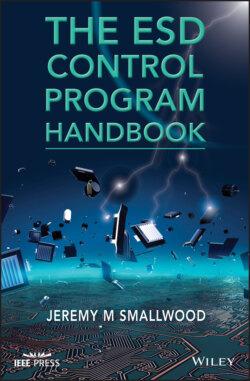Читать книгу The ESD Control Program Handbook - Jeremy M. Smallwood - Страница 62
2.5.2 ESD from Insulating Surfaces
ОглавлениеIf a conductive electrode approaches a charged insulating surface, a “brush” discharge can occur. Several contributory discharges occur on the insulating surface, radiating from a central spark channel – the whole looks rather like an old‐fashioned twig brush.
Brush discharges are less well documented than spark discharges. They typically have a lower peak discharge current than sparks (0.01–10 A) and unidirectional waveforms with fast rise and quasi‐exponential decay (Figure 2.12) (Norberg et al. 1989; Norberg 1992; Norberg and Lundquist 1991; Smallwood 1999; Landers 2018). The power dissipation and energy of a brush discharge is not easy to calculate.
Figure 2.11 The relationship between breakdown voltage and spark gap Pd (Paschen curve).
Figure 2.12 Discharge from negatively charged (>20 kV) insulating surface.
